

How to sew a fly front zipper. I made some shorts last year, quite some time ago now, from a commercial pattern.
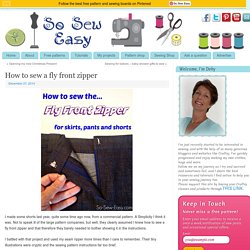
A Simplicity I think it was. Not to speak ill of the large pattern companies, but well, they clearly assumed I knew how to sew a fly front zipper and that therefore they barely needed to bother showing it in the instructions. I battled with that project and used my seam ripper more times than I care to remember. Their tiny illustrations were cryptic and the sewing pattern instructions far too brief. “Install fly front zipper to center front of shorts.” I got there in the end, but it certainly put me off trying it again for a good long time. How to shop for knit fabrics online. Do you ever shop for fabrics online?
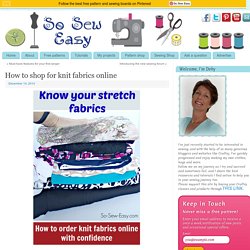
What about shopping for knit and stretch fabrics? Are you confident in where and how to shop for knit fabrics online, and how to make sure you are using the right kind of fabric for your project? I came to sewing only recently so naturally when I wanted to sew clothes, I wanted to emulate the types of clothes already in my wardrobe, and these days most of them are stretch in some way or another. I think some of that has to do with the expanding nature of my body in the last couple of years – I’ve found a stretch garment will fit me over more size changes than a regular woven garment. Must have features for your first serger. Hi there!

I’m Irene and I usually blog at Serger Pepper; today I’m here sharing with you all I know about one of my favorite topics: sergers! Yes, I’ll do my best helping you choosing your first serger (or overlocker, depending on where you come from)… aren’t you excited? I am! Let me start saying that the perfect model does not exist! It’s all relative! Read what you should consider before you start evaluating the models/features: How to install bag feet - 2 styles. I’m always looking for ways to make my homemade bags looks more professional and although it does increase the cost, adding hardware such as clasps, feet, grommets, sliders, straps, rivets, studs and handles really does make them look great.
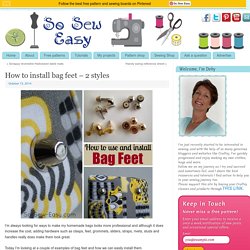
Today I’m looking at a couple of examples of bag feet and how we can easily install them. Both of these examples came from Pacific Trimming. How to sew snap tape to close a pillow back. I’ve been making a few throw pillows (cushions if you are British) just recently and been looking for ways to close the back so they are still easily accessible for removing the insert and washing the cover, but I don’t have any long zips right now (and I admit I’ve not yet ever sewn a zipper into a pillow cover) so I was looking for alternatives.
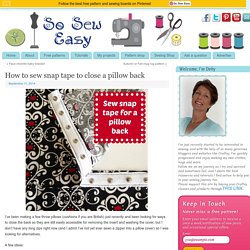
A few ideas: Just step up and learn how to do it with a zipper (added to a future to-do list)Sew on buttons and buttonholes (I’ve got these skills mastered now I think)Use Velco, hook and loop tape (sticks to everything in the wash)Make an ‘envelope’ back that just opens and overlaps (Like my woven fabric pillow and the Oliver the Owl nursery pillow)Just stuff and then sew the pillow closed and unpick when it needs washing (can’t be bothered with that nonsense)Close it with snap tape. I settled on the snap tape. Materials used: Snap tape from Pacific Trimming (available in black or white)Zipper footPillow backA little light-weight interfacing.
Faux chenille baby blanket. After my recent attempt at quilting and all the adventures, failures and very steep learning curve that went into making a baby quilt, I decided for my next expectant friend, a different approach was in order.
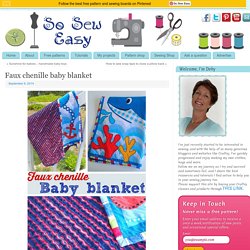
Pinterest to the rescue for inspiration and I came across this tutorial for a faux chenille baby blanket. Although the end result is lovely, it didn’t look easy and even the writer had plenty of problems along the way. Estimating extra fabric for pattern matching (and giveaway) So you’ve got the perfect pattern and you’ve seen the perfect fabric.
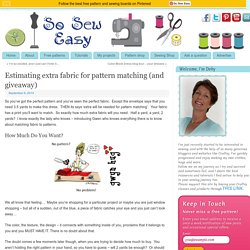
Except the envelope says that you need 3.5 yards to make this dress. THEN its says ‘extra will be needed for pattern matching’. Your fabric has a print you’ll want to match. So exactly how much extra fabric will you need. How to add a zipper pocket to any purse pattern. So you have a basic purse pattern, or have a pattern that includes a basic slip pocket and you would like a zipper pocket.

Not a problem – this sort of thing can usually be added to any bag. You can add them on the outside like in the Nautical Expanding Tote Bag, or on the inside of the bag in the lining like this example from the Carry All Bag. Or both if you want lots of pockets and storage. The exposed zipper can really add a nice pop of color and an interesting design feature to any bag. Here are a few of my tips and tricks to help you insert your first zipper pocket, as part of the My First Bag series of patterns and tutorials.
Tips for buying fabric online and fabric GIVEAWAY. It’s amazing the wonderful people you meet online, and I think sewing people are the best people.
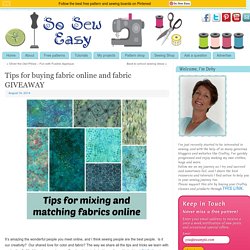
Is it our creativity? Our shared love for color and fabric? The way we share all the tips and tricks we learn with each other? All of the above and more. How to make and use piping. When I sewed my Woven Fabric Pillow, I wanted to make a nice edge to the woven front panel, where it joined to the plain back.
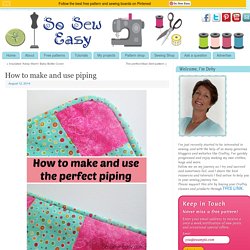
Adding in some piping also helped to give the cover a nice shape and definition. But the focus of my project was really the woven fabric strips and I rushed the piping, not making a perfect job. How to print and assemble a PDF Pattern. One of the comments/questions from the recent survey was about PDF patterns. I forget of course that there are a lot of people out there who haven’t used many PDF’s – since I only started sewing recently PDF patterns were already common and I’ve used far more home-print patterns than tissue paper ones. I very much prefer them, but understand they can be confusing. There are a lot of things you have to get right, and in the right order, for your pattern to be correct. Let’s have a look at all the steps and I’ll try to answer all of your questions I’ve had. What’s so good about PDF print-at-home patterns? Here are some of my patterns that you can get your hands on right away, for example:
Sewing a buttonhole with the buttonhole foot. Did you see my earlier article and video on how to sew on a button with your machine? It wasn’t difficult at all, just a little bit of fiddling to make sure the needle lined up exactly with the button holes. But, I admitted, I’m scared silly of actually sewing the buttonhole. Sewing the perfect narrow hemline. Most garments you sew are going to need some kind of hemline, and there are lots of options to choose from on how to achieve that.
Many of them depend on the type of fabric you are sewing. A knit fabric would require a different approach than a wool or a chiffon for example. Often the type of hemline is dictated by the weight of the fabric. In today’s example, we are looking at the narrow hem. This would be more suitable for light weight fabrics with no stretch and can often be found on gathered skirts, circle skirts and anything where a stiff or wide hem would interfere with the hang of the skirt.
How to sew a hem facing on a circle skirt. I’ve got a project I’m working on that has been giving me a headache. I’ve been itching to make a half-circle skirt but the hemline is just not turning out as I would like. It really is impossible to sew a ‘regular’ hem when the bottom of the skirt is so curved. How to Sew on Buttons with a Sewing Machine.
I’m such a lazy sewer that I feel almost embarrassed to share what I did last week. I had to sew on a couple of buttons and rather than get out a needle and thread and hand-sew them, I actually took the time to look at my machine manual and learn how to sew them by machine instead. In the end, I’m glad I did. They took almost no time at all, looked much neater than I could have sewn by hand, and are probably much stronger too. I can tell you this is easy, because I did this video of me sewing on the very first ever machine sewn button. Both the first one and the second one came out perfectly! The picture above is also a sneak peak of a sewing project you’ll see later this week – but not on this site. What kind of sewing problems are you worried about ?
How to use the overcasting stitches. How to sew a lettuce edge hem. Do you own anything with a lettuce edge hem? Typically seen on little girls clothes, but often in women’s clothing too, on the hemline of casuals and maxi dresses. This curly-wurly hemline looks pretty and is practical too, adding no bulk to the hemline and no fabric is turned up so if you are short on length, this is a good way to finish without making your project shorter. Some knit fabrics stretch just in one direction, others stretch in both directions. Quick and easy gathering with Dental Floss!
Sewing machine practice sheets. The Turned Under Seam Finish. Continuing on in the series about how to sew seams, for those of us without a serger. Use bias tape for a neckline or arm hole facing. Do you have garments you’ve either made or bought that have facings? How a sewing pattern is born. How to sew a French Seam. How did I learn to sew - and how can you? Sewing Glossary of Terms - illustrated. I thought the New Year might be the perfect time to do a quick recap on some sewing terms in case there are any new readers out there or anyone who is looking to start sewing in 2014.
Each craft or profession has their own acronyms and terms which can be a mystery to those starting out, so here is the So Sew Easy Sewing Glossary or Sewing Dictionary. It’s by no means comprehensive! But I think these are the important terms that someone starting out in sewing might need to know. I also have a lot of readers from countries where English is not the first language so this might be useful for you too.
How to download and print PDF sewing patterns. The Flat Felled Seam Finish. Turning corners with bias binding. Continuous Bias Binding Calculator. Making continuous bias binding tape. The Zig-Zag stitch seam finish. Understitching a facing, neckline or lining. Sewing an Invisible Zipper video tutorial. How to use a twin needle. Staystitching - what is it and why do it? Pressing Matters - why press seams as you sew? My DIY Duct Tape Dress Form. Tracing Burda Patterns the EASY Way. Essential sewing tools for beginners. Understanding a sewing pattern envelope. Sewing Tutorials - everything you will ever need to know.
Sewing an Invisible Hem - Sew A Skirt Series. All about Zipper Feet - Sew A Skirt Series. How to choose fabric - How to Sew A Skirt series. How to Sew Darts - How to Sew A Skirt Series. How to mark darts - How to Sew A Skirt Series. Lining a Skirt with Zipper - Sew A Skirt Series. Lining a skirt - Sew A Skirt Series. How to sew an invisible zipper - Sew A Skirt Series. Pattern matching and cutting fabric - Sew A Skirt Series.